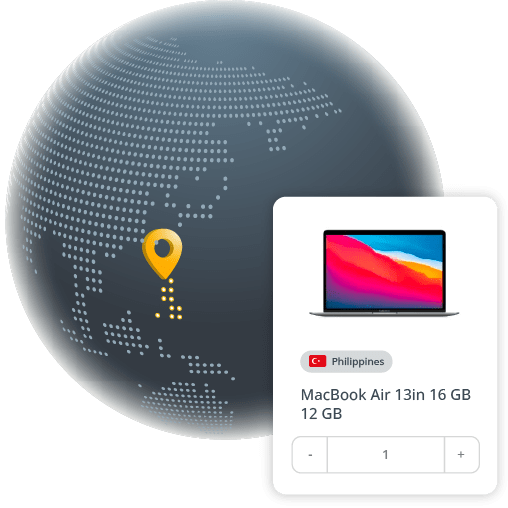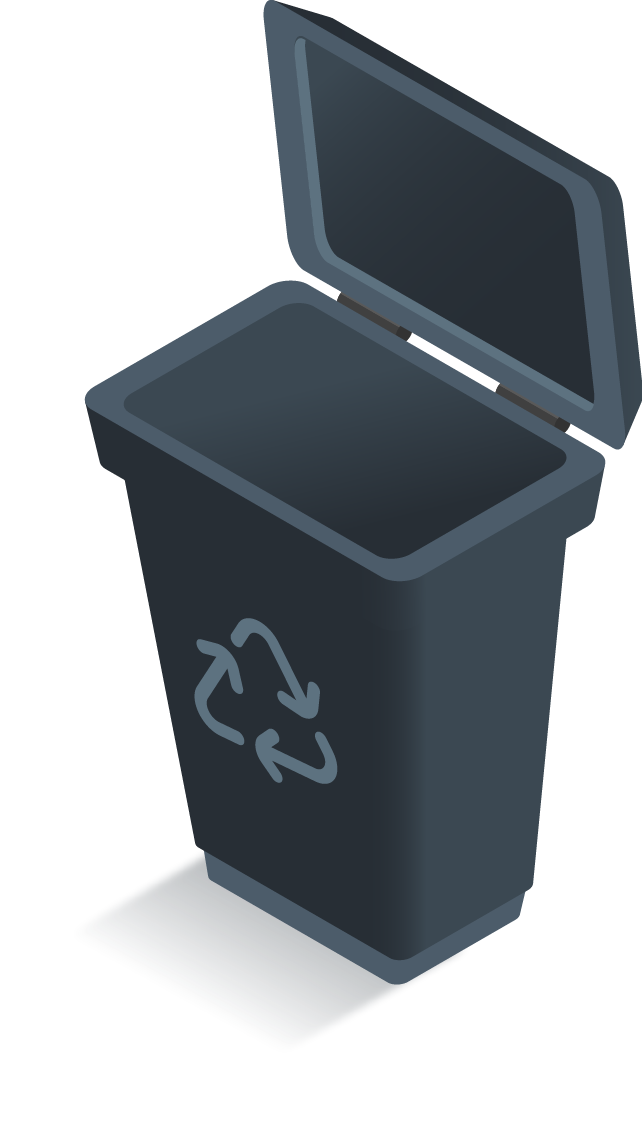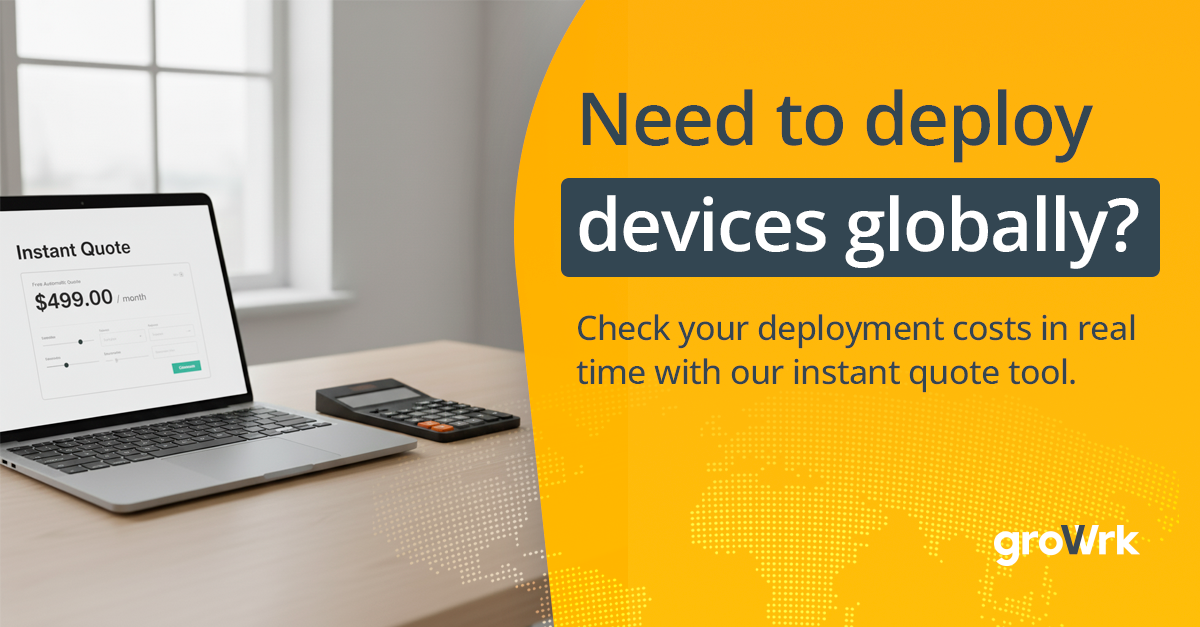How to send IT equipment to the Philippines
Looking to send laptops or other IT equipment to distributed teams in the Philippines? GroWrk simplifies IT asset management, shipping, and compliance across borders. Learn how to seamlessly manage logistics, customs, and IT outsourcing for your remote team.

At a glance
Before shipping IT equipment or outsourcing IT services to the Philippines, there are a few important factors to consider. The Philippines is emerging as a key player in the global IT landscape. Understanding the IT ecosystem is essential for businesses planning to send IT equipment or outsource services to the Philippines.
|
CURRENCY Philippine Peso (PHP) |
OFFICIAL LANGUAGE Filipino and English |
TIME ZONE GMT+08:00 |
|
CUSTOMS DUTY ON ELECTRONICS 0-10% + 12% VAT 0-10% customs duties and 12% VAT depending on the product |
SHIPPING LEAD TIME 7-14 days For standard shipping |
IT OUTSOURCING MARKET $31 billion Digital economy |
Overview of IT operations in the Philippines

Digital transformation: The Philippines is advancing its digital infrastructure, with increasing adoption of cloud computing, artificial intelligence (AI), and Internet of Things (IoT) solutions across various industries. The government's 'cloud-first' policy and initiatives like the Free Wi-Fi for All Act drive this transformation.
Government initiatives: Programs like the Philippine Digital Strategy aim to enhance the country's IT capabilities, encouraging foreign investment and innovation. The Department of Information and Communications Technology (DICT) supports the IT-BPM sector through initiatives like the Digital Cities 2025 Programme, fostering a nurturing ecosystem for innovative development.
Skilled workforce: The Philippines boasts a growing pool of IT professionals with expertise in software development, cybersecurity, and data analytics. The IT and Business Process Management (IT-BPM) industry employs over 1.5 million individuals, contributing significantly to the country's economy.
IT market growth: The Philippine IT market is expected to show rapid growth, with the digital economy projected to reach a gross merchandise value of $31 billion by 2024. This growth is driven by increasing digitalization efforts and a supportive government stance on ICT development.
Geographical advantage: The Philippines' strategic location in Southeast Asia makes it a prime IT service and logistics hub, bridging markets across the Asia-Pacific region. Its young, tech-savvy population and supportive policies further enhance its appeal as a destination for IT services and outsourcing.
Shipping IT equipment to the Philippines: What you need to know
| Customs regulations |
IT equipment like laptops, monitors, and peripherals must comply with Philippine customs regulations. Items must be declared, and proper documentation is required for smooth clearance. |
| Duties and taxes |
According to Philippine import tariffs, customs duties typically range between 0% and 10%, with an additional 12% VAT applied to the total declared value. |
| Required documentation |
|
| Import restrictions |
High-tech items may require special permits or are prohibited. Used items may also need additional certifications. Technology-specific restrictions Certain types of IT equipment may require additional documentation or face import restrictions in the Philippines:
|
| New vs. Used equipment |
|
| Data privacy laws |
The Philippines enforces strict data privacy regulations through the Data Privacy Act (Republic Act No. 10173). Key compliance factors include:
|
| Penalties or fines for non-compliance |
|
Checklist for sending laptops to the Philippines
When shipping laptops to the Philippines, it’s important to follow a few best practices to ensure the process goes smoothly, and your equipment arrives safely and on time. Here are some helpful shipping tips:

Select trusted couriers: Choose reliable couriers such as GroWrk, DHL, UPS, FedEx, or LBC Express for international shipping. These carriers offer tracking services and have experience handling Philippine customs procedures.
Check service levels: Select the appropriate shipping option based on urgency. Express shipping (3-7 days) for high-priority deliveries. Standard shipping (7-14 days) for cost-effective options.
Use high-quality packaging: Secure laptops with sturdy, padded boxes and protective materials like bubble wrap, foam inserts, or air cushions to prevent damage during transit.
Disassemble where possible: If shipping accessories like chargers, docking stations, or monitors, package them separately to prevent damage. Remove detachable components if applicable.
Label clearly: Ensure the recipient’s name, address, and contact details are correctly labeled. Mark the package as "fragile" to encourage careful handling.
Accurate product descriptions: On the commercial invoice, provide a detailed and accurate description of the laptop, including its brand, model, and serial number. Inaccurate descriptions may cause customs delays.
Value declaration: Declare the correct value of the laptop to avoid under- or over-declaring, which could lead to customs inspections or fines. The declared value determines any applicable duties and taxes.
Customs declarations: All international shipments require customs clearance. Include: Philippine Customs Declaration (Bureau of Customs - Import Entry and Internal Revenue Declaration Form), commercial invoice, and packing list
Proof of origin: If applicable, include a certificate of origin to determine eligibility for preferential trade agreements, such as the ASEAN Free Trade Area (AFTA) or the Philippines-U.S. Trade Agreement, which may reduce import duties.
Understand import duties & taxes: Laptops are exempt from import duties but are subject to 12% VAT on the declared value, including shipping costs. Additional customs processing fees may apply depending on the shipment’s value.
Pre-pay duties and taxes: Some couriers allow for pre-paid duties and taxes to simplify customs clearance and prevent the recipient from facing unexpected charges upon arrival.
Protect against loss or damage: Consider purchasing shipping insurance for high-value laptops to protect against loss, theft, or damage during transit.
Compliance with Philippine regulations: Ensure compliance with National Telecommunications Commission (NTC) regulations if the laptop has wireless communication capabilities. Non-compliant devices may be held at customs.
Use tracking tools: Major couriers provide real-time tracking—monitor shipments closely to anticipate customs clearance updates and delivery progress.
Stay in touch with the recipient: Notify the recipient about the expected delivery timeline, tracking updates, and any customs-related requirements to avoid delays.
Expect weather and seasonal delays: Typhoons, heavy rains, and peak shipping demand during holidays (e.g., Christmas, Black Friday, Chinese New Year) may cause delivery delays. Plan shipments accordingly.
Philippine domestic delivery options: For final delivery, consider working with LBC Express, J&T Express, 2GO, or Ninja Van for efficient last-mile distribution.

Average cost of IT Equipment in the Philippines
Laptops (Business Grade):
- Mid-range: $600 - $1,200
- High-end: $1,200 - $2,500+
High-end models such as Apple MacBook Pro, Dell XPS, and Lenovo ThinkPad are priced on the higher end.
Monitors (Business Grade):
- Standard: $150 - $300
- Ultrawide/4K: $400 - $1,000
Monitors from trusted brands like Dell, Samsung, and LG typically range within these prices, with 4K or ultrawide models costing more.
Desktops (Business Grade):
- Standard Desktop PC: $500 - $1,500
- Workstation Desktop (for high-performance tasks): $1,500 - $3,500+
Prices depend on the brand and specifications, with options from HP, Lenovo, and Apple among the most common.
Printers (Laser):
- Standard Office Printers: $150 - $400
- High-Volume Printers: $600 - $2,000+
Leading brands such as HP, Canon, and Brother offer a wide range of models for office environments.
Public holidays & IT work hours to plan your shipment
-
Key public holidays in the Philippines:
- New Year’s Day: January 1
- Independence Day: June 12
- Christmas Day: December 25
- Holy Week (Maundy Thursday and Good Friday): Dates vary based on the Christian calendar
- Bonifacio Day: November 30
- Rizal Day: December 30
Typical work hours for IT professionals
- In the Philippines, the standard workweek for IT professionals typically follows a 40-hour schedule, usually from 9:00 AM to 6:00 PM, with a one-hour lunch break. However, in the technology sector, many IT professionals, especially those in roles like software development or project management, may have flexible hours or remote work arrangements. These flexible working hours can help align schedules with global teams or reduce downtime.
What to consider when retrieving IT equipment from employees in the Philippines
| Local delivery and logistics services |
|
| Inventory management |
|
| Logistics challenges for remote locations |
Logistics can become challenging in some remote or rural regions of the Philippines. Here are key factors to consider:
|
| Equipment agreement with employees |
|
How to dispose of IT equipment in the Philippines
E-waste recycling:
IT equipment such as laptops, monitors, and other electronics must be disposed of through certified e-waste recycling programs. Consult with licensed e-waste disposal companies, such as Envirocycle and Greenday Recycling, which specialize in managing and recycling electronic waste responsibly.
Data Destruction
Before disposing of or repurposing any IT equipment, ensure that all sensitive data is completely erased to comply with data protection laws, such as the Data Privacy Act (Republic Act No. 10173). Data destruction should be done using certified methods, such as data wiping software or physical destruction of hard drives.
Repurposing or donating
If the equipment is still functional, it can be repurposed internally or donated to educational institutions, non-profits, or other organizations needing IT resources.

Local IT Outsourcing Solutions in the Philippines
You can streamline your IT logistics and asset management with GroWrk’s comprehensive global solution. Whether it’s shipping equipment or managing IT assets across multiple regions, GroWrk helps you stay compliant and efficient, every step of the way. Here’s why GroWrk is the ideal partner for managing your IT assets in the Philippines:

| 1. Wide global coverage |
With operations in over 150 countries, including the Philippines, GroWrk guarantees seamless IT deployment and management for remote teams. Whether your employees are in Manila, Cebu, Davao, or remote locations, we ensure timely and hassle-free service to keep your business running smoothly. |
| 2. End-to-end asset management |
GroWrk simplifies the entire IT asset lifecycle, covering procurement, deployment, management, and retirement. By handling logistics, compliance, and security, we allow your team to focus on business growth while we manage IT operations. |
| 3. Intuitive platform for easy deployment |
Our user-friendly platform makes ordering, shipping, and tracking IT equipment across the Philippines effortless. Employees receive pre-configured, ready-to-use devices, reducing administrative overhead and ensuring seamless onboarding. |
| 4. Smooth delivery and equipment retrieval |
From delivering laptops, monitors, and IT accessories to remote employees across the Philippines to retrieving assets from departing team members, GroWrk handles it all. We make the process efficient and fully traceable, eliminating logistical challenges. |
| 5. Compliance with Philippine import regulations |
The Philippines has strict customs, tax, and compliance requirements for IT shipments. GroWrk ensures BPS certification, WEEE disposal, and tax compliance, preventing delays, penalties, or unexpected costs. |
| 6. Efficient repairs and maintenance |
We manage hardware repairs, replacements, and maintenance to keep IT assets in top working condition. Whether through on-site servicing or remote troubleshooting, GroWrk minimizes downtime and ensures business continuity. |
| 7. 24/7 Support for peace of mind |
From shipping assistance and compliance management to real-time troubleshooting, GroWrk’s 24/7 support ensures smooth IT operations, keeping your remote workforce in the Philippines fully equipped. |
Procure, configure, and deploy your IT devices from one platform


